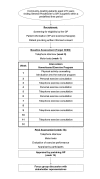Feasibility of a multidimensional home-based exercise programme for the elderly with structured support given by the general practitioner's surgery: study protocol of a single arm trial preparing an RCT [ISRCTN58562962]
- PMID: 19686587
- PMCID: PMC2753322
- DOI: 10.1186/1471-2318-9-37
Feasibility of a multidimensional home-based exercise programme for the elderly with structured support given by the general practitioner's surgery: study protocol of a single arm trial preparing an RCT [ISRCTN58562962]
Abstract
Background: Physical activity programmes can help to prevent functional decline in the elderly. Until now, such programmes use to target either on healthy community-dwelling seniors or on elderly living in special residences or care institutions. Sedentary or frail people, however, are difficult to reach when they live in their own homes. The general practitioner's (GP) practice offers a unique opportunity to acquire these people for participation in activity programmes. We conceptualised a multidimensional home-based exercise programme that shall be delivered to the target group through cooperation between GPs and exercise therapists. In order to prepare a randomised controlled trial (RCT), a feasibility study is being conducted.
Methods: The study is designed as a single arm interventional trial. We plan to recruit 90 patients aged 70 years and above through their GPs. The intervention lasts 12 weeks and consists of physical activity counselling, a home-exercise programme, and exercise consultations provided by an exercise therapist in the GP's practice and via telephone. The exercise programme consists of two main components: 1. a combination of home-exercises to improve strength, flexibility and balance, 2. walking for exercise to improve aerobic capacity. Primary outcome measures are: appraisal by GP, undesirable events, drop-outs, adherence. Secondary outcome measures are: effects (a. motor tests: timed-up-and-go, chair rising, grip strength, tandem stand, tandem walk, sit-and-reach; b. telephone interview: PRISCUS-Physical Activity Questionnaire, Short Form-8 Health Survey, three month recall of frequency of falls, Falls Efficacy Scale), appraisal by participant, exercise performance, focus group discussion. Data analyses will focus on: 1. decision-making concerning the conduction of a RCT, 2. estimation of the effects of the programme, detection of shortcomings and identification of subgroups with contrary results, 3. feedback to participants and to GPs.
Conclusion: A new cooperation between GPs and exercise therapists to approach community-dwelling seniors and to deliver a home-exercise programme is object of research with regard to feasibility and acceptance. In case of success, an RCT should examine the effects of the programme. A future implementation within primary medical care may take advantage from the flexibility of the programme.
Trial registration: Current Controlled Trials ISRCTN58562962.
Figures
References
-
- Demographischer Wandel in Deutschland. Heft 1 Bevölkerungs- und Haushaltsentwicklung im Bund und in den Ländern. Tech. rep., Statistische Ämter des Bundes und der Länder, Wiesbaden. 2007.
-
- Wurm S, Tesch-Römer C. In: Altwerden in Deutschland [Aging in Germany] Tesch-Römer C, Engstler H, Wurm S, editor. Wiesbaden: VS Verlag für Sozialwissenschaften; 2006. Gesundheit, Hilfebedarf und Versorgung [Health, medical requirements and medical care] pp. 329–383.
-
- Nelson ME, Rejeski WJ, Blair SN, Duncan PW, Judge JO, King AC, Macera CA, Castaneda-Sceppa C. Physical activity and public health in older adults: Recommendation from the American College of Sports Medicine and the American Heart Association. Circulation. 2007;9(9):1094–1105. doi: 10.1007/s11556-007-0024-z. - DOI - PubMed
Publication types
MeSH terms
Associated data
LinkOut - more resources
Full Text Sources
Medical


